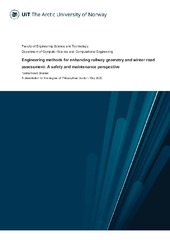| dc.contributor.advisor | Bianchi, Filippo Maria | |
| dc.contributor.advisor | Anfinsen, Stian Normann | |
| dc.contributor.author | Hansen, Jonas Berg | |
| dc.date.accessioned | 2021-09-15T14:38:51Z | |
| dc.date.available | 2021-09-15T14:38:51Z | |
| dc.date.issued | 2021-06-01 | en |
| dc.description.abstract | Power flow analysis is an important tool in power engineering for planning and operating power systems. The standard power flow problem consists of a set of non-linear equations, which are traditionally solved using numerical optimization techniques, such as the Newton-Raphson method. However, these methods can become computationally expensive for larger systems, and convergence to the global optimum is usually not guaranteed. In recent years, several methods using Graph Neural Networks (GNNs) have been proposed to speed up the computation of the power flow solutions, without making large sacrifices in terms of accuracy. This class of models can learn localized features that are independent from a global graph structure. Therefore, by representing power systems as graphs these methods can, in principle, generalize to systems of different size and topology. However, most of the current approaches have only been applied to systems with a fixed topology and none of them were trained simultaneously on systems of different topology. Hence, these models are not fully shown to generalize to widely different systems or even to small perturbations of a given system. In this thesis, several supervised GNN models are proposed to solve the power flow problem, using established GNN blocks from the literature. These GNNs are trained on a set of different tasks, where the goal is to study the generalizability to both perturbations and completely different systems, as well as comparing performance to standard Multi-Layered Perceptron (MLP) models. The experimental results show that the GNNs are comparatively successful at generalizing to widely different topologies seen during training, but do not manage to generalize to unseen topologies and are not able to outperform an MLP on slight perturbations of the same energy system. The study presented in this thesis allowed to draw important insights about the applicability of GNN as power flow solvers. In the conclusion, several possible ways for improving the GNN-based solvers are discussed. | en_US |
| dc.identifier.uri | https://hdl.handle.net/10037/22551 | |
| dc.language.iso | eng | en_US |
| dc.publisher | UiT Norges arktiske universitet | no |
| dc.publisher | UiT The Arctic University of Norway | en |
| dc.rights.holder | Copyright 2021 The Author(s) | |
| dc.rights.uri | https://creativecommons.org/licenses/by-nc-sa/4.0 | en_US |
| dc.rights | Attribution-NonCommercial-ShareAlike 4.0 International (CC BY-NC-SA 4.0) | en_US |
| dc.subject.courseID | STA-3941 | |
| dc.subject | VDP::Matematikk og Naturvitenskap: 400::Matematikk: 410::Anvendt matematikk: 413 | en_US |
| dc.subject | VDP::Mathematics and natural science: 400::Mathematics: 410::Applied mathematics: 413 | en_US |
| dc.subject | VDP::Matematikk og Naturvitenskap: 400::Matematikk: 410::Statistikk: 412 | en_US |
| dc.subject | VDP::Mathematics and natural science: 400::Mathematics: 410::Statistics: 412 | en_US |
| dc.subject | Machine Learning | en_US |
| dc.subject | Deep Learning | en_US |
| dc.subject | Energy Analytics | en_US |
| dc.subject | Graph Neural Network | en_US |
| dc.subject | Power System | en_US |
| dc.subject | Numerical Optimization | en_US |
| dc.title | Power Flow Optimization with Graph Neural Networks | en_US |
| dc.type | Mastergradsoppgave | nor |
| dc.type | Master thesis | eng |


 English
English norsk
norsk



